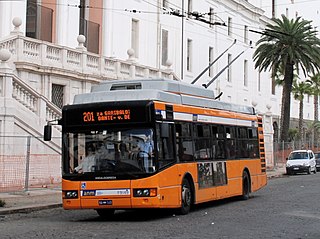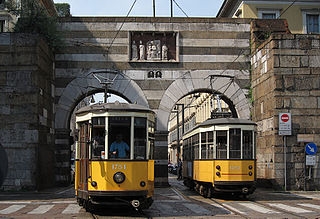
Geneva Public Transport operates most of the public transportation system in canton of Geneva, Switzerland, including the city of Geneva. The agency's head office is in Grand-Lancy, Lancy.

The Boston-area trolleybussystem forms part of the public transportation network serving Greater Boston in the U.S. state of Massachusetts. It opened on April 11, 1936, and since 1964 has been operated by the Massachusetts Bay Transportation Authority (MBTA). The current system consists of the Silver Line (Waterfront), located in the city of Boston. Prior to 1964, several additional trolleybus lines were in operation in Greater Boston, including a group of routes in and around Cambridge, outside Boston proper, that comprised the metropolitan area's only trolleybus service during the period 1964–2004. Measured by fleet size, the system was the third-largest trolleybus system in the United States at its peak, with only the Chicago and Atlanta systems having more trolleybuses than Boston's 463.

A Warsaw trolleybus system formed part of the public transport network of Warsaw, the capital city of Poland, during two separate periods. The first trolleybus system was established in 1946 and lasted until 1973. It had a maximum of 10 routes. The second system, comprising only one route, was in operation from 1983 until 1995. Between 1992 and its closure, it was operated by Zarząd Transportu Miejskiego (ZTM), in English the Public Transport Authority (Warsaw).

Lugano railway station is the main railway station of the city of Lugano, in the Swiss canton of Ticino. The station is on the Gotthard railway and is also the terminus of the Lugano Città–Stazione funicular. The metre gauge Lugano–Ponte Tresa Railway (FLP) has a separate station at Lugano FLP railway station across the station forecourt from the main line station.

Trolleybuses in Naples provide a portion of the public transport service in the city and comune of Naples, in the region of Campania, southern Italy. Two independent trolleybus systems are in operation, both publicly owned. That of Azienda Napoletana Mobilità (ANM) opened in 1940, whereas the smaller trolleybus network of Compagnia Trasporti Pubblici di Napoli (CTP) opened in 1964. As of 2021, the ANM system has five routes – one of which are temporarily suspended – and the CTP has one. Worldwide, Naples is one of only two metropolitan areas possessing two independent trolleybus systems as of 2011, the other being São Paulo, Brazil.

The Parma trolleybus system forms part of the public transport network of the city and comune of Parma, in the region of Emilia-Romagna, northern Italy. In operation since 1953, the system presently comprises four urban routes.

The Sanremo trolleybus system or San Remo trolleybus system, also known as the Italian Riviera trolleybus, is focused on the town and comune of Sanremo, in the region of Liguria, northwestern Italy.

The Milan tramway network is part of the public transport network of Milan, Italy, operated by Azienda Trasporti Milanesi (ATM).

The Modena trolleybus system forms part of the public transport network of the city and comune of Modena, in the region of Emilia-Romagna, northern Italy.

The Lausanne trolleybus system forms part of the public transport network of Lausanne, in the canton of Vaud, Switzerland. The system has been in operation since 1932 and is the third-oldest surviving trolleybus system in the world, after those of Shanghai and Philadelphia.

The Fribourg trolleybus system forms part of the public transport network in Fribourg, capital of the canton of Fribourg, Switzerland. The system also serves the neighbouring municipalities of Villars-sur-Glâne and Givisiez, using one line in each case.

The La Chaux-de-Fonds trolleybus system forms part of the public transport network in La Chaux-de-Fonds, in the canton of Neuchâtel, Switzerland.

The Neuchâtel trolleybus system is part of the public transport network in Neuchâtel, Switzerland. Opened in 1940, it gradually replaced the urban lines of the Neuchâtel tramway network.

The St. Gallen trolleybus system forms part of the public transport network of St. Gallen, the capital city of the canton of St. Gallen, Switzerland.

The Lucerne trolleybus system forms part of the public transport network of Lucerne, capital city of the canton of Lucerne, Switzerland. Opened in 1941, the system had replaced the Lucerne tramway network by 1961.

Trasporti Pubblici Luganesi (TPL) is a public transport operator in and around the Swiss city of Lugano. Previously known as the Società luganese dei tramway elettrici, Tranvie elettriche comunali, Azienda comunale del traffico (ACT) and Azienda comunale dei trasporti della Città di Lugano (ACTL), the organisation was founded in 1884 and adopted its current name in 2000.

The Montreux/Vevey trolleybus system, also known as the Vevey–Villeneuve trolleybus line, forms part of the public transport network in Montreux and Vevey, in the canton of Vaud, Switzerland. It comprises a single 12.75 km (7.92 mi) long trolleybus route along the length of the Riviera vaudoise on the north shore of Lake Geneva.

The Schaffhausen trolleybus system is part of the public transport network of Schaffhausen, capital city of the canton of Schaffhausen, Switzerland. It is also Switzerland's youngest and smallest such system.

The Lugano tramway network was part of the public transport network of Lugano, in the canton of Ticino, Switzerland, for over half a century. Opened in 1896, the network was progressively replaced by the Lugano trolleybus system by 1959, with one independent line surviving until 1964.




























